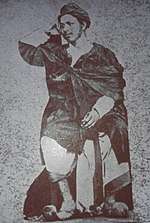Govardhanram Tripathi
Govardhanram Madhavram Tripathi (pronounced [ɡoʋəɾd̪ʱənɾɑːm mɑːd̪ʱəʋɾɑːm t̪ɾipɑʈʰiː] (![]()
Govardhanram Madhavram Tripathi | |
|---|---|
| Born | 20 October 1855 Nadiad (now in Gujarat), Bombay presidency, British India |
| Died | 4 January 1907 (aged 51) Mumbai, Bombay presidency, British India |
| Occupation | Lawyer, novelist, poet, literary critic, literary historian |
| Nationality | Indian |
| Notable works | Saraswatichandra |
| Spouse | Harilakshmi
( m. 1868; died 1874)Lalitagauri ( m. 1875) |
| Relatives | Mansukhram Tripathi (cousin) |
| Website | |
| Official website | |
Life

Govardhanram was born in Vadnagara nagar brahmin family on 20 October 1855 on the day of the Dashera festival at Nadiad, Bombay presidency (now in Gujarat), to his mother, Shivkashi, and his father, Govardhanram. He took his primary education from the Buddhivardhak Gujarati Shala in Mumbai and Government English School at Nadiad. Thereafter, he joined Elphinstone High School from where he passed his matriculation examination in 1871. In the same year, he joined Elphinstone College to obtain his BA degree. He passed his BA examination at the second attempt, in 1875.[2][3]
After three unsuccessful attempts, he passed LLB examination in 1883, and started working as a lawyer in Mumbai in 1884. At the age of 43, he retired early and settled in his hometown to contribute to Gujarati literature and public service.[4][3]
Govardhanram died in Mumbai on the evening of 4 January 1907.[3]
Personal life
In 1868, Govardhanram married Harilakshmi, who died in 1874 in a child birth, leaving behind a daughter, Radha, who also died soon after. In 1876, he married Lalitagauri,[5][3] who gave birth to three daughters, Lilavati (b. 1881), Jashvanti (b. 1884) and Jayanti (b. 1888); and a son, Ramaniyaram (b. 1886).[6] He was a younger cousin of Gujarati writer Mansukhram Tripathi.[7]
Works

In 1875, he read a paper, A Rude Outline of the General Features of Practical Asceticism in My Sense of the World, before the Friendly Society. According to Gujarati critic Balwantray Thakore, this paper can be considered the key-stone of Govardhanram's ideology, aspiration and character.[3]
In 1887, the first volume of Saraswatichandra was published, and was followed by volumes 2, 3 and 4 in 1892, 1898, and 1901, respectively; each volume have a separate subtitle: The Administration of Buddhidhan, The Family-maze of Gunasundari, The Political Administration of Ratnanagari and The Dreamland of Saraswati.[1] The novel represents the life of Gujarat during the early part of 19th-century and also focuses on contemporary social, political, philosophical and cultural issues. It is believed that Govardhanram has sketched his own various personality through this novel.[8]
He also took an active role in the Indian Congress during 1902; and in 1905, he was elected as the first president of Gujarati Sahitya Parishad. He also wrote various articles and essays in the papers 'Vasant' and 'Samalochak', which were later published as books.
His other works includes Snehamudra, Leelavati Jeevankala (Lilavati's Art of Living), Navalramnu Kavijeevan (Navalram's life as a poet), Dayaramno Akshardeh (The Literary Works of Dayaram), Sadavastu Vichar, and Scrap Book, an autobiographical work.[1]
His Classical Poets of Gujarat is a critical works with a historical approach. It discusses about Gujarati poets Mira, Narsinh Mehta, Akho, Premananda and Shamal; and the influence of these poets and their works on society and morals.[9]
Legacy


The period from 1885 to 1915 is called "Govardhan-Yug" or "Govardhan-Era" in Gujarati literature. On 27 April 2016, a commemorative postage stamp was released by Indian Posts to honour Govardhanram Tripathi. The Chief Minister of Gujarat, Anandiben Patel, released the postage stamp in Gandhinagar.[10][11][12]
References
- R. P. Malhotra (2005). Encyclopaedic Dictionary of Asian Novels and Novelists: A-I. New Delhi: Global Vision Publishing House. p. 290. ISBN 978-81-8220-067-8. Retrieved 15 March 2018.
- Suhrud 1999, p. 201.
- Joshi, Ramanlal (1979). Govardhanram. Makers of Indian Literature. New Delhi: Sahitya Akademi. pp. 5–6. OCLC 6950984.
- Suhrud 1999, p. 202.
- Suhrud 1999, p. 245.
- Suhrud 1999, p. 253.
- Shukla, Sonal (1995). "Gujarati Cultural Revivalism". In Patel, Sujata (ed.). Bombay: Mosaic of Modern Culture. New Delhi: Oxford University Press. p. 93. ISBN 978-0-19-563689-5.
- Mehta, Chandrakant (2005). Indian classics - Gujarati. Translated by Maru, Pallavi. New Delhi: Publications Division, Ministry of Information and Broadcasting, Government of India. pp. 1–2. ISBN 978-81-230-1120-2.
- Shastri, Prithvinath; Lal, P. (1974). The Writers Workshop Handbook of Gujarati Literature (A-F.). 1. Calcutta: Writers Workshop. p. 58. OCLC 2236764.
- "Gujarat CM releases postal stamp of Shri Govardhanram Tripathi". DeshGujarat. 27 April 2016. Retrieved 14 March 2018.
- "Stamp Released on Gujrati Writer Govardhanram Tripathi". PhilaMirror. 28 April 2016.
- "Archived copy". Archived from the original on 1 May 2016. Retrieved 2 May 2016.CS1 maint: archived copy as title (link)
Sources
- Suhrud, Tridip (1999). "Consumption as Dharma: Govardhanram Tripathi and the Dissolution of the Self" (PDF). Narrations of a Nation: Explorations Through Intellectual Biographies (Ph.D thesis). Ahmedabad: School of Social Sciences, Gujarat University. hdl:10603/46631.CS1 maint: ref=harv (link)
Further reading
- Pandya, Kantilal Chhaganlal (1965). Pandya, Upendra (ed.). Sriyut Govardhanram (in Gujarati) (2nd ed.). Mumbai: N. M. Tripathi Pvt. Ltd. OCLC 24453446.
External links
| Wikisource has original text related to this article: |